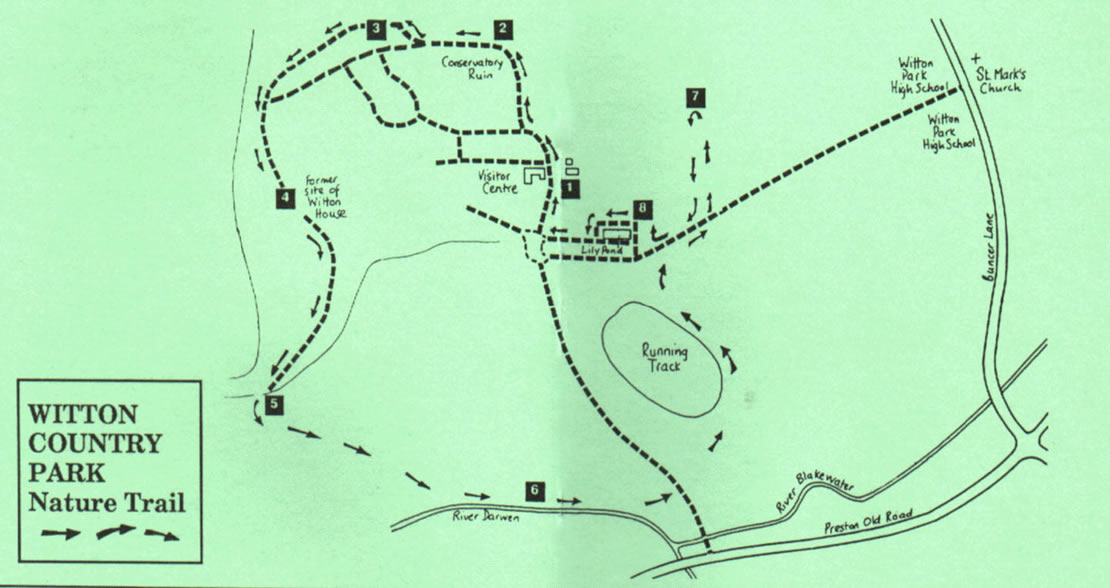The Nature Trail
Map of the nature trail
The nature trail describes some of the natural history features that can be seen in Witton Country Park and around the visitor centre. The trail stations are identified by numbered posts and the direction signs are designated by red arrows. The nature trail is about 1.5 miles long and you can brake of at any time and be completed at any time.
STATION 1: VISITOR CENTRE
There are many interesting plants to be seen here they include ivy and ivy-leaved toadflax. Unlike most other plants, ivy flowers in autumn, the purple berries ripening in early spring. Ivy-leaved toadflax grows on walls and has an interesting method of seeding, the stalk turns away from the light and pushes seeds in to the wall where ever it may be.
Many birds nest here including song thrush, blackbirds, wrens, robins, blue tits, blackcap and spotted flycatcher. Ivy-covered walls are the favoured spot.
STATION 2: THE YEW TREES
You can pick out the yew trees from the other evergreens. They tolerate shallow soils and little can grow in their dense shade, Both leaves and seeds are poisonous to people and animals.
The seeds are surrounded by a red fleshy substance favoured by birds in the autumn, e.g. Thrushes and blackbirds. Also yellow loosestrife grows near hear during the summer months.
STATION 3: OAK/BEACH WOODLAND
Many oak trees, both young and old grow here. The two main British species are the sessile and the pedunculate (the English) oak. The latter is a tree of lowland areas, and has stalked acorns, whereas those of the sessile oak are unstalked. On the oak look out for oak apples contain several.
Look to the right of this station to see the evergreen tree with dark leaves it is a Holm oak, and is an introduced species. And note the acorns.
There are several magnificent beech near here and in autumn both beech (mast) and oak (acorns) provide food for grey squirrels, jays and wood pigeons.
A good beech crop only occurs about one year in four, and acorns are also unreliable. The grey squirrel, introduced from the U. S. A., is very common and has replaced the native red throughout most of England.
There are two cut-leaf beech near here - they are a variety of the common beech. Note how little grows under beech because of their dense shade.
STATION 4: PLANT COLONIZATION
Many plants have colonized here since the house was demolished in 1954. A good example is broom, a member of the pea family, with yellow flowers and adapted to growing in dry areas.
Distinguished from gorse by absence to thorns. Most colonizing flowers are to be seen in late spring and summer and include birds foot trefoil, tufted vetch, harebell, yarrow, black knapweed, rib worth plantain, heath bedstraw and tormentil.
Two interesting butterfly's to be seen here are the orange-tip (in spring) and the large skipper (in summer).
STATION 5: MOWN GRASSLAND
The view east and west, up and down the river Darwen, is across a wide flood-plain formed from glacial sands and gravels deposited in what was Lake Blackburn (Lake Accrington) by water flowing from an ice- sheet.
The grassland here is mown regularly in summer and you will see some plants which have adapted to these conditions e.g. daisy and rat's tail plantain, with rosettes of leaves very close to the ground.
In springtime starlings collect food for their young here. They eat harmful insects and grubs which damage grass roots, particularly wireworms (a beetle larvae) and leather-jackets (crane fly or daddy-long-legs larvae.
STATION 6: RIVERSIDE FLORA
A profusion of wild flowers grow along the river bank, from coltsfoot in early spring to michaelmas daisy in late summer. Conditions favour plant growth here because of the damp, rich soil and lack of shade. Plants to be seen in spring and summer include wood anemone, sweet ciceil, cow parslet, common hogweed. Figwort, ragwort, Himalayan balsam, meadow cranesbill and Japanese knotweed.
This last-named is extremely invasive, can grow up to 2 meters or more, and unless controlled will force out other vegetation.
STATION 7: THE MARSH
This station is just inside big cover wood, near the car park. Pussy willow and alder indicate the damp conditions here. The alder catkins open in early spring before the leaves. The fruit are produced in small cones which persist on the tree all year. The seeds with their floats, are adapted for dispersal in water. Sometimes in spring, alder are attacked by woolly aphids which are tiny insects like greenfly.
They cluster around the twigs in white, woolly masses.
The yellow flowers of the marsh marigold are prominent in spring, and reed canary grass and Himalayan balsam in summer.
STATION 8: POND LIFE
There is a swamp cypress at each end of the pond. A native of Florida, it has buttress roots to give support in marshy terrain.
INSECTS
Water beetles, dragonflies (e.g. common aeshna), damsel flies and pond skaters.
PLANTS
Common duckweed, Canadian pond weed, yellow water lily and branched bur-reed
SNAILS FISHES AND WORMS
Snails, fishes and worms thrive in the pond, for example ramshorn snail; perch. Roach and stickleback; and horse leeches.



